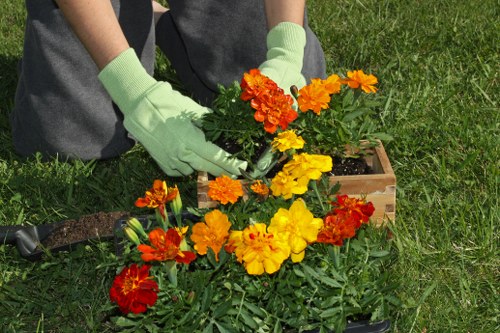Hedge Trimming in Edmonton: Enhance Your Garden's Beauty

Maintaining well-shaped and healthy hedges is essential for any beautiful garden. In Edmonton, where the climate can be quite challenging, proper hedge trimming not only enhances the aesthetic appeal of your property but also promotes the health and longevity of your plants. Whether you're a homeowner looking to spruce up your backyard or a business owner aiming to improve your commercial landscape, understanding the intricacies of hedge trimming is crucial.
Edmonton's unique climate, with its cold winters and warm summers, requires specific trimming techniques to ensure that hedges remain robust and vibrant throughout the year. Regular trimming helps prevent diseases, encourages new growth, and maintains the desired shape and size of your hedges. In this comprehensive guide, we'll explore the best practices for hedge trimming in Edmonton, the types of hedges suitable for the region, and professional services available to help you achieve impeccable results.
Whether you're dealing with small shrubs or large hedges, the right tools and techniques can make a significant difference. From choosing the appropriate time for trimming to understanding the specific needs of different hedge varieties, this article will provide you with all the information you need to keep your hedges in top condition.

Why Hedge Trimming is Important
Hedge trimming is more than just an aesthetic practice; it plays a vital role in the overall health of your plants. Proper trimming can:
- Promote Healthy Growth: Removing dead or diseased branches encourages new growth and prevents the spread of infections.
- Maintain Shape and Size: Regular trimming helps maintain the desired shape and size of your hedges, ensuring they complement your garden or property.
- Improve Sunlight Exposure: Trimming allows more sunlight to reach the inner parts of the hedge, promoting even growth and reducing the risk of fungus.
- Enhance Curb Appeal: Well-maintained hedges significantly enhance the visual appeal of your property, making it more inviting.
In Edmonton, where seasons change dramatically, hedge trimming also helps your plants prepare for winter by removing weak branches that might be damaged by snow and ice. This proactive approach can save you time and effort in maintaining your hedges year-round.
Ignoring hedge maintenance can lead to overgrowth, making it difficult to manage and potentially hazardous if branches interfere with power lines or pathways. Therefore, regular hedge trimming is essential for both the health of your plants and the safety and beauty of your property.

Best Times for Hedge Trimming in Edmonton
Timing is critical when it comes to hedge trimming. In Edmonton, the optimal times for trimming hedges are during the late spring and late summer. Here's why:
Late Spring (May to June)
Trimming in late spring allows plants to recover quickly from pruning before the heat of summer sets in. This period is ideal for shaping and controlling the growth of your hedges. Additionally, trimming during this time can stimulate new growth, giving your plants a lush and full appearance.
Late Summer (August to September)
Late summer trimming helps prepare your hedges for the upcoming winter months. By removing excess growth, you reduce the risk of snow and ice accumulation breaking branches. This timing also ensures that your plants have enough time to harden off before the cold weather arrives, promoting better resilience against harsh winter conditions.
Avoid Trimming During Extreme Weather
It's advisable to avoid hedge trimming during extreme heat or frost periods. Trimming too early in the spring can damage budding branches, while trimming too late in the fall can leave your hedges vulnerable to winter damage.

Types of Hedges Suitable for Edmonton
Choosing the right type of hedge is essential for the success of your landscaping efforts in Edmonton. Some popular and resilient hedge varieties suitable for the region include:
Boxwood (Buxus)
Boxwood is a classic choice for formal hedges due to its dense, evergreen foliage and ability to hold intricate shapes. It's well-suited to Edmonton's climate, providing year-round greenery.
Privet (Ligustrum)
Privet is a fast-growing hedge option that offers thick coverage and can be easily trimmed into various shapes. It's particularly useful for creating privacy screens.
Yew (Taxus)
Yew hedges are highly versatile and tolerant of heavy pruning. They are excellent for creating tall, dense barriers and can thrive in both sun and shade.
Holly (Ilex)
Holly plants provide attractive, evergreen foliage and bright berries, adding visual interest to your garden. They are hardy and can withstand Edmonton's winter conditions.
Laurel (Prunus)
Laurel hedges are known for their glossy leaves and rapid growth rate. They are ideal for creating thick, lush barriers that require frequent trimming.
Consider Native Species
Incorporating native plant species can enhance the biodiversity of your garden and ensure better adaptability to Edmonton's climate. Native hedges often require less maintenance and are more resistant to local pests and diseases.

Essential Tools for Hedge Trimming
Having the right tools is crucial for effective and efficient hedge trimming. Here are the essential tools you'll need:
Shears
Handheld shears are perfect for precise trimming and shaping of smaller hedges. They allow for detailed work and are essential for maintaining the overall shape of your plants.
Hedge Trimmers
Electric or gas-powered hedge trimmers are ideal for larger hedges and heavy-duty trimming tasks. They provide a clean cut and save time compared to manual shears.
Loppers
For thicker branches that are beyond the capacity of shears or trimmers, loppers are necessary. They offer the strength needed to handle tougher stems.
Pruning Saw
A pruning saw is useful for cutting through larger branches that cannot be managed with loppers. It ensures smooth and clean cuts, which are vital for the health of the hedge.
Protective Gear
Wearing protective gloves, safety glasses, and appropriate clothing can prevent injuries while trimming hedges. Safety should always be a priority when using cutting tools.
Maintenance of Tools
Regular maintenance of your trimming tools ensures they remain effective and safe to use. Sharp blades make cleaner cuts, reducing the risk of plant damage and disease spread. Clean your tools after each use and store them in a dry place to prevent rusting.

Step-by-Step Guide to Trimming Hedges
Proper technique is essential for successful hedge trimming. Follow this step-by-step guide to achieve professional-looking results:
- Assess the Hedge: Examine the overall shape, health, and growth patterns of your hedge. Identify any diseased or damaged branches that need to be removed.
- Choose the Right Time: As mentioned earlier, late spring and late summer are ideal times for trimming hedges in Edmonton.
- Gather Your Tools: Ensure you have all the necessary tools ready and in good condition.
- Start with the Sides: Begin trimming the sides of the hedge, maintaining a consistent shape. Use a horizontal line as a guide to ensure an even trim.
- Trim the Top: Carefully trim the top of the hedge, ensuring it is level. Avoid cutting too much, as this can stress the plant.
- Remove Dead or Diseased Branches: Cut away any branches that appear unhealthy to prevent the spread of disease.
- Clean Up: Collect and dispose of trimmings to keep the area tidy and prevent pests.
By following these steps, you can maintain a neat and healthy hedge that enhances the beauty of your Edmonton property.

Common Mistakes to Avoid
Even with the best intentions, certain mistakes can hinder the health and appearance of your hedges. Here are some common pitfalls to avoid:
- Over-Trimming: Cutting too much foliage at once can stress the plant and slow its growth. Aim for gradual shaping over multiple trimming sessions.
- Incorrect Timing: Trimming at the wrong time of year can damage budding branches or leave your hedge vulnerable to winter damage.
- Using Dull Tools: Dull blades can tear branches, making them more susceptible to disease. Always ensure your tools are sharp and well-maintained.
- Ignoring Plant Health: Failing to remove diseased or damaged branches can lead to infestations and the spread of plant diseases.
- Uneven Trimming: Inconsistent trimming can result in an unbalanced and unattractive hedge. Use guides and take your time to ensure even cuts.
Avoiding these mistakes will help you maintain healthy, attractive hedges that enhance your Edmonton landscape.
Seek Professional Help When Needed
If you're unsure about the proper techniques or lack the time and tools for effective hedge trimming, consider hiring a professional landscaping service. Professionals have the expertise and equipment to ensure your hedges are trimmed correctly and safely.
Investing in professional services can save you time and ensure the longevity and beauty of your hedges, making it a worthwhile consideration for Edmonton homeowners and businesses alike.

Choosing the Right Hedge Trimming Service in Edmonton
Selecting a reliable and experienced hedge trimming service is essential for achieving the best results. Here are some factors to consider when choosing a service provider:
Experience and Expertise
Look for companies with a proven track record in hedge trimming and general landscaping. Experienced professionals understand the specific needs of different hedge varieties and the Edmonton climate.
Reputation and Reviews
Check online reviews and ask for references to gauge customer satisfaction. A reputable service provider will have positive feedback and testimonials from previous clients.
Range of Services
Choose a company that offers a comprehensive range of services, including hedge trimming, pruning, shaping, and maintenance. This ensures all your landscaping needs are met efficiently.
License and Insurance
Ensure the service provider is licensed and insured. This protects you in case of any accidents or damages during the trimming process.
Competitive Pricing
While quality should be a priority, it's also important to consider the cost. Obtain quotes from multiple providers to compare prices and find a service that fits your budget without compromising on quality.
Environmentally Friendly Practices
Consider companies that use eco-friendly practices, such as proper disposal of green waste and the use of sustainable tools. This contributes to the overall health of your garden and the environment.

DIY Hedge Trimming Tips
If you prefer to handle hedge trimming yourself, here are some tips to ensure success:
Plan Your Trim
Before you start, plan the shape and size of your hedge. Use strings or guides to mark the desired lines, ensuring symmetry and consistency.
Start with Clean Cuts
Always make clean, sharp cuts to promote healthy healing. Avoid tearing or crushing branches, which can lead to disease.
Work in Sections
Divide the hedge into manageable sections and trim each part individually. This approach helps maintain control over the shape and prevents over-trimming.
Step Back Frequently
Periodically step back and assess your progress from different angles. This helps you maintain an even and balanced appearance throughout the trimming process.
Maintain Consistency
Ensure that each trimming session follows the same guidelines to maintain the overall shape and health of your hedge.
Safety First
Always prioritize safety when trimming hedges. Wear protective gear, use stable ladders, and be cautious when handling tools to prevent injuries.

Aftercare for Trimmed Hedges
Proper aftercare is essential to ensure your hedges recover well from trimming and continue to thrive:
Watering
Provide adequate water, especially during dry spells, to help your hedges recover and promote new growth.
Fertilizing
Apply a balanced fertilizer to supply essential nutrients, encouraging healthy development and vibrant foliage.
Monitoring for Pests and Diseases
Regularly inspect your hedges for signs of pests or diseases. Early detection and treatment can prevent significant damage.
Mulching
Apply a layer of mulch around the base of your hedges to retain moisture, regulate soil temperature, and suppress weed growth.
Regular Maintenance
Incorporate hedge trimming into your regular garden maintenance schedule to prevent overgrowth and ensure ongoing health and beauty.
Seasonal Care
Adapting your aftercare routine to the changing seasons can further enhance the resilience of your hedges. Protect your plants during extreme weather and adjust watering and fertilizing schedules as needed.

Benefits of Professional Hedge Trimming Services
While DIY trimming can be rewarding, professional hedge trimming services offer numerous advantages:
- Expertise: Professionals have the knowledge and experience to handle various hedge types and conditions.
- Efficiency: Trained crews can complete trimming tasks more quickly and effectively than individual efforts.
- Safety: Professionals are equipped with the necessary safety gear and techniques to perform trimming without accidents.
- Quality Results: Professional trimming ensures clean cuts and precise shaping, enhancing the overall appearance of your hedges.
- Time-Saving: Hiring experts frees up your time to focus on other aspects of garden maintenance or personal activities.
Investing in professional services can lead to healthier, more visually appealing hedges, adding value to your Edmonton property.
Customized Services
Many professional hedge trimming services offer customized packages tailored to your specific needs. Whether you require one-time trimming or regular maintenance, you can find a service plan that suits your preferences and budget.
Warranty and Guarantees
Reputable companies often provide warranties or satisfaction guarantees, ensuring that the job is done to your standards. This offers peace of mind and assurance of quality workmanship.

Cost of Hedge Trimming in Edmonton
The cost of hedge trimming in Edmonton can vary based on several factors, including the size of the hedge, the type of plants, and the complexity of the trim required. On average, you can expect the following price ranges:
- Small Hedges: CAD 50 - CAD 100 per hour
- Medium Hedges: CAD 100 - CAD 200 per hour
- Large or Complex Hedges: CAD 200 - CAD 500 or more
Additional costs may apply for services such as tree removal, pest control, or specialized treatments. It's advisable to obtain quotes from multiple service providers to compare prices and ensure you receive a fair rate for the quality of work.
Factors Affecting Cost
The following factors can influence the cost of hedge trimming services in Edmonton:
- Hedge Size and Density: Larger and denser hedges require more time and effort, increasing the overall cost.
- Accessibility: Hedges that are difficult to access may require specialized equipment or additional labor, adding to the cost.
- Frequency of Service: Regular maintenance contracts may offer discounted rates compared to one-time services.
- Additional Services: Services such as pest treatment, fertilization, or aesthetic shaping can increase the total cost.
Understanding these factors can help you budget appropriately and choose a service that aligns with your financial expectations.

Environmental Impact of Hedge Trimming
Sustainable hedge trimming practices are essential for minimizing the environmental impact and promoting a healthy ecosystem:
Proper Disposal of Trimmings
Dispose of hedge trimmings responsibly by composting or using green waste disposal services. Avoid burning or dumping trimmings in waterways, which can contribute to pollution.
Minimize Chemical Use
Opt for natural pest control and fertilizing methods to reduce chemical runoff and protect local wildlife. Integrated pest management strategies can effectively control pests without harming the environment.
Encourage Biodiversity
Incorporate a variety of native plants in your hedge to support local pollinators and beneficial insects. Diverse plant life enhances the resilience of your garden and supports a balanced ecosystem.
Eco-Friendly Tools
Using electric or manual hedge trimmers instead of gas-powered ones can reduce carbon emissions and noise pollution. Additionally, maintaining your tools to ensure energy efficiency contributes to environmental sustainability.
Water Conservation
Implement water-efficient practices, such as mulching and drip irrigation, to conserve water and maintain healthy hedges. Proper watering techniques prevent overuse of water resources and promote sustainable garden maintenance.

Innovations in Hedge Trimming
The landscaping industry is constantly evolving with new technologies and methods that make hedge trimming more efficient and effective:
Advanced Hedge Trimmer Designs
Modern hedge trimmers feature ergonomic designs, lightweight materials, and enhanced safety features, making them easier to use and reducing fatigue during prolonged trimming sessions.
Automated Trimming Systems
Automated hedge trimming systems and robotic trimmers are emerging, offering precise and consistent trimming without the need for manual labor. These innovations save time and ensure uniform results.
Sustainable Practices
Eco-friendly trimming techniques and tools are being developed to reduce the environmental footprint of landscaping activities. This includes the use of renewable energy sources and sustainable materials in tool production.
Digital Planning Tools
Landscape design software and mobile applications help homeowners and professionals plan and visualize hedge trimming projects. These tools facilitate better planning and execution, leading to superior results.
Integration with Smart Gardening
Smart gardening technologies, such as sensors and automated irrigation systems, integrate seamlessly with hedge trimming practices. These technologies optimize plant care and maintenance, ensuring healthy and well-maintained hedges.

Conclusion: Elevate Your Edmonton Landscape with Expert Hedge Trimming
Hedge trimming is a fundamental aspect of garden and landscape maintenance, offering numerous benefits that enhance the beauty and health of your property. In Edmonton, where the climate presents unique challenges, adopting the right trimming techniques and choosing appropriate hedge varieties are essential for achieving stunning and resilient hedges.
Whether you decide to tackle hedge trimming yourself or hire a professional service, understanding the best practices, necessary tools, and aftercare methods will ensure your hedges thrive year-round. Investing in regular maintenance not only boosts the aesthetic appeal of your garden but also contributes to the overall value and sustainability of your outdoor space.
Ready to transform your garden with impeccable hedge trimming? Contact us today to schedule a consultation and discover how our expert services can help you achieve the lush, beautifully shaped hedges you've always desired.

Frequently Asked Questions
How Often Should I Trim My Hedges?
Generally, hedges should be trimmed 2-3 times a year—early spring, midsummer, and late summer. However, the frequency may vary depending on the hedge type and growth rate.
Can I Trim my Hedges During Winter?
It's best to avoid heavy trimming during winter as plants are dormant. Light trimming can be done to remove dead branches, but major pruning should wait until spring.
What Are the Signs That My Hedge Needs Trimming?
Signs include overgrown branches, uneven shape, reduced plant health, and restricted sunlight reaching the inner parts of the hedge.
Should I Remove All the Trimmed Branches?
Yes, removing all trimmed branches helps prevent the spread of diseases and keeps the area tidy. Composting is a sustainable option for disposal.
Is It Necessary to Fertilize After Trimming?
Fertilizing after trimming can support new growth and replenish nutrients lost during the trimming process, promoting overall hedge health.

Get Started with Professional Hedge Trimming Today
Don't wait to enhance the beauty and health of your hedges. Book your service now and let our team of experts in Edmonton provide you with top-notch hedge trimming solutions tailored to your specific needs.

